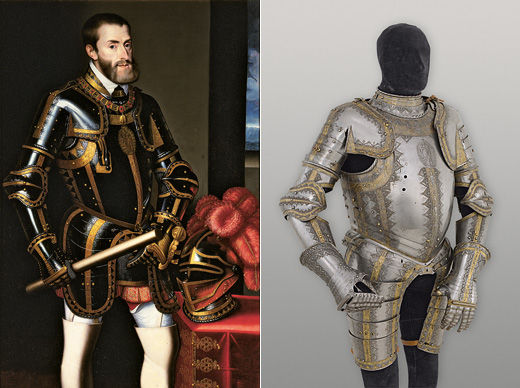Yes, I can see that it is a blueish-gray...thing.
That doesn't answer my question.
Balin Greyjoy is the Lord of the Iron Islands -- not much of a domain compared to the rest of Westeros, but a significant realm, and according to him he is not just its lord, but its king. And yet there he is, wearing rough-spun cloth (of an indeterminate identity) dyed a dismal color. He does not look kingly.
What gets me about this costume is that it is quite clear what the costumers are doing here -- they are establishing something of Greyjoy's character, and contrasting him with the other Lords of Westeros*. Greyjoy is not a man of comfort, and the Iron Isles are not a comfortable place, so he wears ugly clothes. This makes a kind of narrative sense.
But it comes at the cost of a larger believability; costuming can't just serve a narrative purpose, it should also make sense. At its best, it can help flesh out the world that the characters live in.
Looking kingly (as Varys might tell us) is a big part of being a king, and it always has been, and never so much as in feudal societies -- those with power and wealth need to exhibit it, so that those around them know just how formidable they are. This touches just about every aspect of what kings do, from extravagant tournaments to generous (if sporadic) alms for the poor to their castles and palaces to theclothes they wore -- everything is an expression of their power. Kings in the Middle Ages and Renaisance knew this, and they always kept it in mind -- even their armour (which risks getting seriously banged up whenever a king goes to war) shows off their wealth.
The Armour of Charles V, in portrait and in person. This is not 'show' armour, it is for the batlefield. The gilding was applied in the same process that tempered the steel.
Clothes were a particularly important status symbol, to the point where sumptuary laws were passed governing the sort of clothes that every class could wear -- it just would not do to have merchants using their money to dress like kinds. These laws covered everything from the colors people could wear to the furs they could trim their gowns with to how pointy their shoes could be.
Westeros is not medieval Europe, but like many fantasy worlds (with some notable exceptions, like Middle Earth) its society is so heavily based on medieval europe that the same social forces apply -- in Westeros as in medieval Europe, rulers (and the ruling classes) must project their power. When the costuming of the show forgets this, it is a failure of world-building.
Westeros is not medieval Europe, but like many fantasy worlds (with some notable exceptions, like Middle Earth) its society is so heavily based on medieval europe that the same social forces apply -- in Westeros as in medieval Europe, rulers (and the ruling classes) must project their power. When the costuming of the show forgets this, it is a failure of world-building.
Another HBO program that had the same problem (but more egregiously, since it was a historical) was the John Adams miniseries, particularly the early episodes. John Adams, one of the most prominent lawyers in Boston, goes to court wearing a rough homespun coat. It beggars imagination. Here again the costuming choices served characterization (Adams is a simpler man than Hancock or the radical aristocrat Jefferson, both of whom dress very finely). Here again they didn't ultimately make sense.
As an example of a show that does this right, I might point to Deadwood, also by HBO. I'm not an expert in 1870's fashion, but each of the characters dresses in a way that expresses who they are and which makes sense in their world. Al Swearengen is a second-wave pioneer, the first of the shopkeeps, saloonkeeps and pimps that moved into camp to get rich off of a captive market of miners. As a businessman he has pretensions to respectability, so he wears his coat whenever he's downstairs in his establishment or walking around town. As a rough character, though, he isn't dressed properly -- he rarely wears his shit collar or a tie. Contrast this with the former sheriff Seth Bullock, who dresses 'properly' unless he's laboring physically. His careful appearance helps characterize him as a civilized person. Similarly, the proprietors of the new hotel in season 1 always wear frock coats and ties, contrasting them with the rough Swearengen. In all these cases the costuming both signals to lay viewers who these characters are, and still makes sense in the wider social context.
*I suppose some of this might have to do with the Iron Islands' silly pirate code, but the less I think of such contrived 'cultures' the better -- real human beings do not build their society around some romantic ideal. But that is another issue, and a failure of fantasy worldbuilding not restricted to Westeros.


No comments:
Post a Comment